|
|
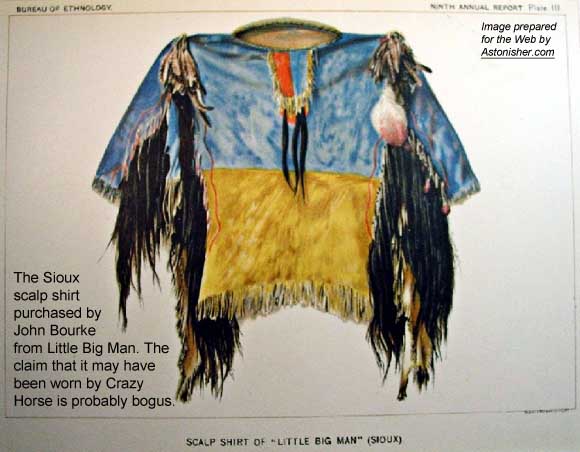
ONE OF the enduring mysteries of Crazy Horse is whether or not he ever allowed himself to be photographed. Most of the people who knew him personally -- such as Horn Chips, Billy Garnett and Dr. Valentine McGillycuddy -- agreed that "he never had his picture taken... He was very peculiar about that."
Typical of the ever elusive Tasunka Witko, though, there is contradictory testimony. Short Bull, a fellow Oglala and a long-time associate of Crazy Horse, said he had personally seen three photographs of Crazy Horse, all showing him on horseback, once on the pinto he rode at the Little Bighorn and the Rosebud.
No authenticated photograph of Crazy Horse -- on horseback or otherwise -- has ever emerged, but several nominees have been put forward since his murder. Here are the main candidates, and the reasons why none of them is, in fact, a photo of Crazy Horse.
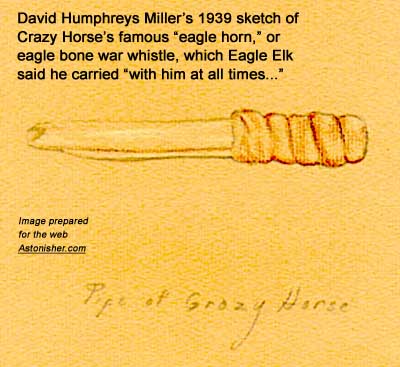 Still, the dream persists that Short Bull was correct, and somewhere in some musty archive there is a picture of an unknown Indian on a pinto war pony. This is the El Dorado of Crazy Horse studies. Still, the dream persists that Short Bull was correct, and somewhere in some musty archive there is a picture of an unknown Indian on a pinto war pony. This is the El Dorado of Crazy Horse studies.
* * *
At present, all that remains of Crazy Horse in this world are a few eye-witness descriptions and a few physical artifacts, some of which are also probably bogus.
For instance, although it may possibly have been part of his one time Shirt-Wearer paraphernalia, the purported Crazy Horse scalp shirt in the collection of the American Bureau of Ethnography (which was purchased by from Little Big Man by John Bourke) was probably never worn in battle Crazy Horse, since all accounts agree that he always fought unadorned, e.g. Lazy White Bull's description of Crazy Horse at the Little Bighorn.
Among the Crazy Horse artifacts that are likely to have been real personal possessions, the most significant is his Eagle Horn -- or eagle bone war whistle -- sketched by William Humphreys Miller in 1939. Crazy Horse used the Eagle Horn to command his warriors, and Eagle Elk said he carried with him "at all times."
For more info on Crazy Horse, see The Complete Crazy Horse Surrender Ledger, The Wintercount of Crazy Horse's Life, Crazy Horse at the Little Bighorn, Crazy Horse at the Rosebud, and the May 7, 1877 Chicago Times story.
-- Bruce Brown
April 21, 2007
Updated November 16, 2010
|
|
|
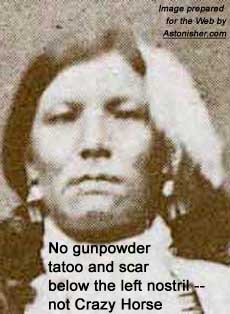
|
|
#1
The "Little Bat" /
Carroll Friswold Photo
|
|
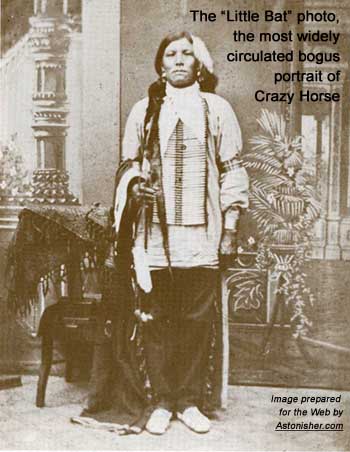 |
|
|
| The most frequently seen bogus portrait of Crazy Horse is the "Little Bat" photo. Supposedly taken in 1877 at Fort Robinson, NE, and supposedly originally owned by Baptiste "Little Bat" Garnier, this image was first published in 1956 in J.W. Vaughn's With Crook at the Rosebud, and endorsed by Custerania author Carroll Friswold, who conveniently owned the small 2 1/2 by 3 1/2 inch tintype at the time.
On the face of it, it's hard to see why the "Little Bat" photo has been so widely accepted. As this fair copy of the photo from the first edition of Vaughn's book clearly shows, this unknown Indian had neither a bullet scars nor gunpowder tattooing just below the left nostril and eye, where Crazy Horse had been shot point blank in the face, and survived.
Even if you set aside the tangled story of the "Little Bat" Photo's supposed origin, this is clearly not Crazy Horse. Next!
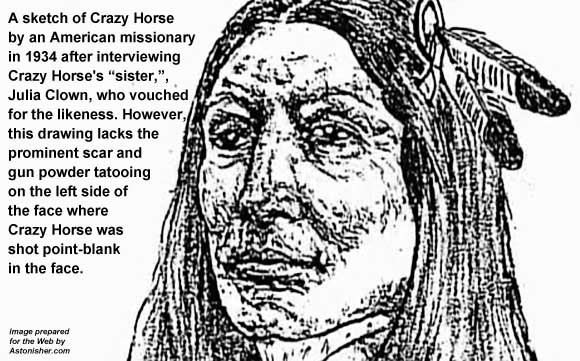 #2 #2
The Mormon Missionary Drawing
Another commonly seen (thanks to Wikipedia and History Detectives) bogus portrait of Crazy Horse is this drawing of Crazy Horse by a Mormon missionary in 1934 after interviewing Crazy Horse's sister, Julia Clown, who vouched for the likeness. This gives it some credibility, but like #1 on the Astonisher.com Bogus Crazy Horse Picture List, this drawing -- which was made 58 years after Crazy Horse was murdered by America -- has neither the bullet scar nor the gunpowder tattoo just on the left side of his face, where Crazy Horse had been shot point blank. Next! |
|
|
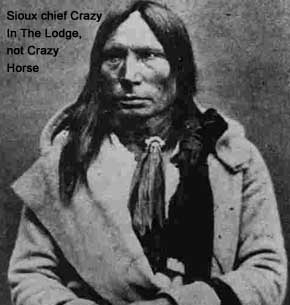
#3 --
The S.J. Morrow Photo
Another commonly seen bogus portrait of Crazy Horse is this photo by Stanley J. Morrow. Even if you don't know that this photo was identified by Morrow himself as Sioux chief Crazy In The Lodge, "head warrior under Spotted Tail," this is clearly not Crazy Horse for the same reason as Bogus Crazy Horse Photo #1: no gunpowder tattoo or gunshot wound below the left nostril. Next!
|
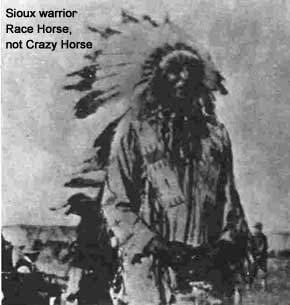
#4 --
The Race Horse /
Ft. Robinson Photo
This bogus portrait of Crazy Horse purports to show the Oglala war chief at Ft. Robinson in 1876. Even if you don't know that Crazy Horse wasn't at Ft. Robinson in 1876 (he didn't surrender until May 1877), this is clearly not Crazy Horse either. There are two giveaways here. The first is his head gear: a rare point of agreement among people who knew Crazy Horse is that he never wore an eagle feather war bonnet. The second is the age of this unknown Indian, who is at least middle aged, while Crazy Horse was by most accounts a young-looking 36 or 37 at the time of his death. This Indian is sometimes identified as Race Horse, a purported cousin of Crazy Horse.
|
|
|
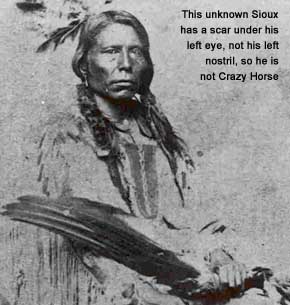
#6 --
The Hawk Wing Photo
This unknown Sioux has a scar under his left eye -- not his left nostril -- so he is not Crazy Horse.
Interestingly, though, he appears to be holding the wing of a hawk, which was Crazy Horse's Wasicunpi (or guardian spirit). His hair also appears lighter than most Indians (e.g., the Indian in the "Little Bat" photo above) -- which was true of Crazy Horse -- and he has a "long straight nose," as Little Killer described Crazy Horse. |
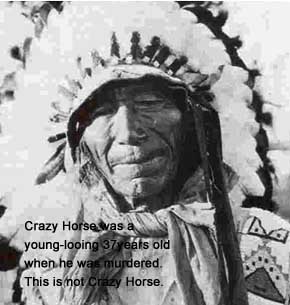
#7 --
The Old Man Photo
The giveaway on this bogus Crazy Horse photo is the same as Bogus Crazy Horse Photo #3: Crazy Horse "never wore a warbonnet" and was a young-looking man in his thirties when he was murdered. This elderly Indian is not Crazy Horse.
|
|
Crazy Horse's Wives,
Black Shawl Woman
and Nellie Lavarie? |
|
|
| This Standing Bear family photo from Crazy Horse: A Lakota Life by Kingsley M. Bray purports to portray Crazy Horse's second wife, Black Shawl Woman.
Personally, I have doubts about the authenticity of this photo for a couple reasons. First, the woman in this photo does not have the emaciated, sunken look of a consumptive near death. Secondly, Black Shawl Woman died of TB shortly after Crazy Horse was murdered in 1877, while the building behind this woman looks too substantial to have existed at Ft. Robinson in 1877.
The bottom photo, from The Death of Crazy Horse: A Tragic Episode in Lakota History edited by Richard G. Hardorff, purports to show Crazy Horse's third wife, Helen "Nellie" Lavarie.
Click here for more info on Crazy Horse's women.
|
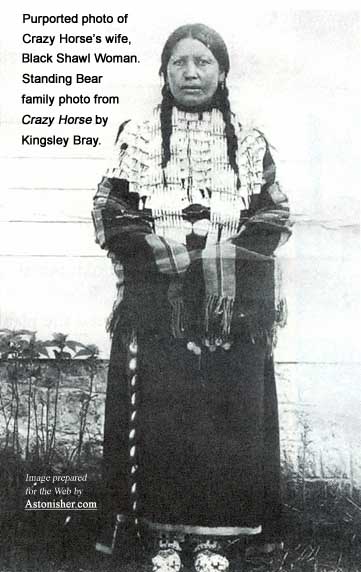
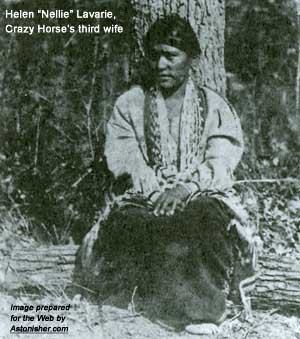
|
|
With Crook at the Rosebud by J W Vaughn, Stackpole Co., Harrisburg, PA, 1956
The Killing of Chief Crazy Horse: Three Eyewitness Views with commentary by Carroll Friswold, The Arthur H. Clark Co., Glendale, CA 1976 p 45 - 47
To Kill An Eagle: Indian Views of the Last Days of Crazy Horse by Edward and Mabel Kadlecec, Johnson Books, Boulder, CO 1981 p 72 - 74
The Death of Crazy Horse: A Tragic Episode in Lakota History edited by Richard G. Hardorff, Bison Books, Lincoln, NE, and London 2001 p 70 - 83
Life and Adventures of Frank Grouard by Joe DeBarthe, University of Oklahoma Press 1958 p 53 - 54
The Nebraska Indian Wars Reader edited by R. Eli Paul, University of Nebraska Press, Lincoln, NE 1998, p 185 - 188
Crazy Horse: A Lakota Life by Kingsley M. Bray, University of Oklahoma Press, Norman, OK, 2006
For more information on Crazy Horse, please see Crazy Horse at the Little Bighorn and Crazy Horse at the Rosebud, the Winter Count of Crazy Horse's Life, the Crazy Horse Surrender Ledger, and the Chicago Times' coverage of Crazy Horse's surrender
© Copyright 1973 - 2020 by Bruce Brown and BF Communications Inc.
Astonisher, Astonisher.com, Conversations With Crazy Horse, 100 Voices, Who Killed Custer?, The Winter Count of Crazy Horse's Life, and Mysteries of the Little Bighorn are trademarks of BF Communications Inc.
BF Communications Inc.
P.O. Box 393
Sumas, WA 98295
(360) 927-3234
Website by Running Dog  |
|
|





|























